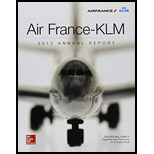
(3) (a)
Receivables:
Receivables refer to an amount to be received in future. General classifications of receivables are
Bad debt expense is an expense account. The amounts of loss incurred from extending credit to the customers are recorded as bad debt expense. In other words, the estimated uncollectible accounts receivable are known as bad debt expense.
Following financial figures are reported in the financial statements of A products Incorporation for the year ended December 31, 2013 (figures in million dollars).
To determine: The amount of gross trade accounts receivable at the end of the year.
(3) (b)
The amount of bad debts expenses for the year.
(3) (c)
The amount of actual bad debts write-offs made during the year.
(3) (d)
The amount of cash collected from customers during the year.
Want to see the full answer?
Check out a sample textbook solution
Chapter 7 Solutions
LooseLeaf Intermediate Accounting w/ Annual Report; Connect Access Card
- Do fast solve this questionarrow_forwardSuppose a stock had an initial price of $66 per share, paid a dividend of $1.8 per share during the year, and had an ending share price of $80. Compute the percentage of total return. a. 23.94% b. 19.75% c. 29.70% d. 25.14%arrow_forwardAccounting answer with solutionarrow_forward
- Accounting answer with correct solutionarrow_forwardValley Tech Inc. reported the following balances at the end of the year: Credit Sales: $250,000 Accounts Receivable: $45,000 Allowance for Uncollectible Accounts before adjustment: $2,000 debit Valley Tech estimates that 5% of the credit sales will be uncollectible. What is the net realizable value of accounts receivable after the year-end adjustment?arrow_forwardXYZ Co. has an average collection period of 45 days. Total credit sales for the year were $3,200,000. What is the balance in accounts receivable at year-end? (Use 360 days in a year. Round to the nearest dollar.)arrow_forward
- Please explain the solution to this general accounting problem using the correct accounting principles.arrow_forwardProperty, Plant & Equipment (Non-current Assets) 1.Define PPE and explain its treatment under IAS 16.2.Compare the cost model vs. revaluation model, including pros, cons, and theoretical implications (e.g., relevance vs. reliability).3.Calculate depreciation using both straight-line and reducing balance methods for an asset costing $500,000 with an expected life of 10 years and residual value of $50,000.4.Explain how impairment and disposals affect PPE reporting and financial results.arrow_forwardSub - General Accountarrow_forward

 AccountingAccountingISBN:9781337272094Author:WARREN, Carl S., Reeve, James M., Duchac, Jonathan E.Publisher:Cengage Learning,
AccountingAccountingISBN:9781337272094Author:WARREN, Carl S., Reeve, James M., Duchac, Jonathan E.Publisher:Cengage Learning, Accounting Information SystemsAccountingISBN:9781337619202Author:Hall, James A.Publisher:Cengage Learning,
Accounting Information SystemsAccountingISBN:9781337619202Author:Hall, James A.Publisher:Cengage Learning, Horngren's Cost Accounting: A Managerial Emphasis...AccountingISBN:9780134475585Author:Srikant M. Datar, Madhav V. RajanPublisher:PEARSON
Horngren's Cost Accounting: A Managerial Emphasis...AccountingISBN:9780134475585Author:Srikant M. Datar, Madhav V. RajanPublisher:PEARSON Intermediate AccountingAccountingISBN:9781259722660Author:J. David Spiceland, Mark W. Nelson, Wayne M ThomasPublisher:McGraw-Hill Education
Intermediate AccountingAccountingISBN:9781259722660Author:J. David Spiceland, Mark W. Nelson, Wayne M ThomasPublisher:McGraw-Hill Education Financial and Managerial AccountingAccountingISBN:9781259726705Author:John J Wild, Ken W. Shaw, Barbara Chiappetta Fundamental Accounting PrinciplesPublisher:McGraw-Hill Education
Financial and Managerial AccountingAccountingISBN:9781259726705Author:John J Wild, Ken W. Shaw, Barbara Chiappetta Fundamental Accounting PrinciplesPublisher:McGraw-Hill Education





